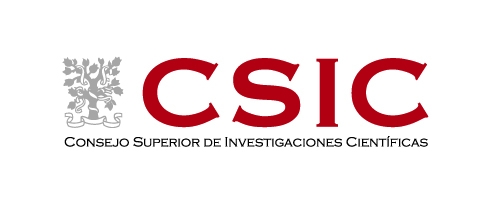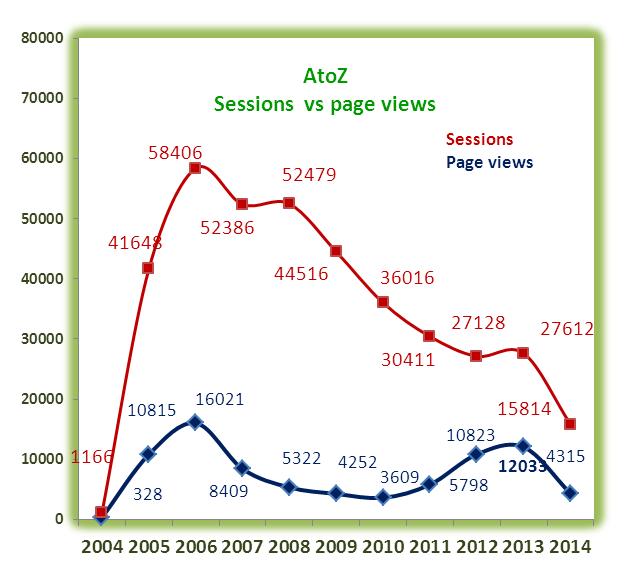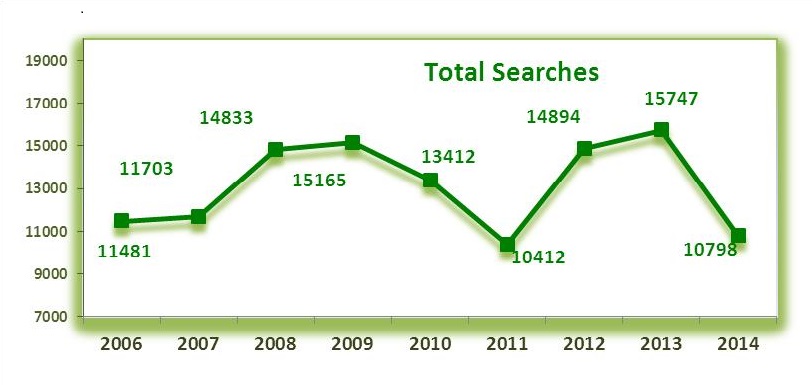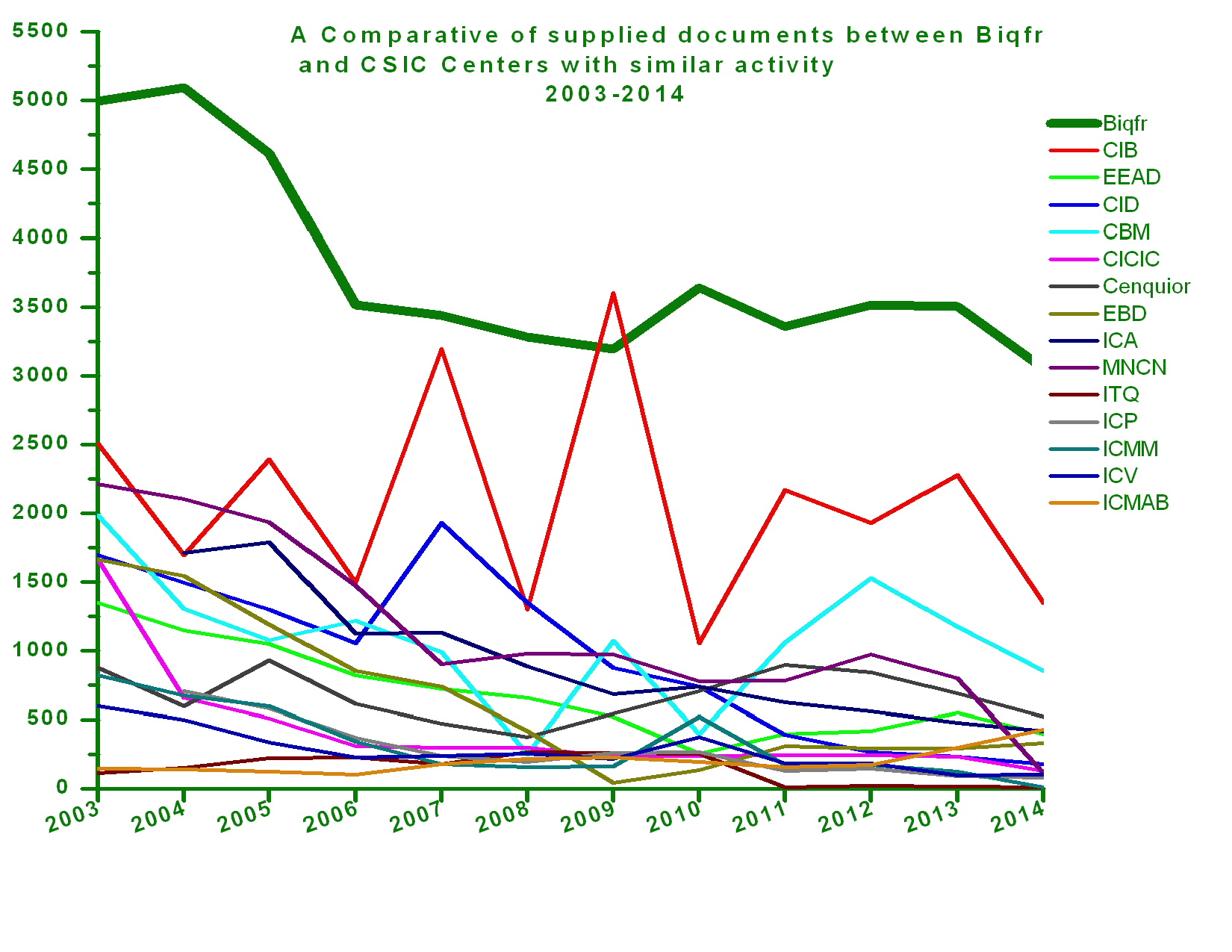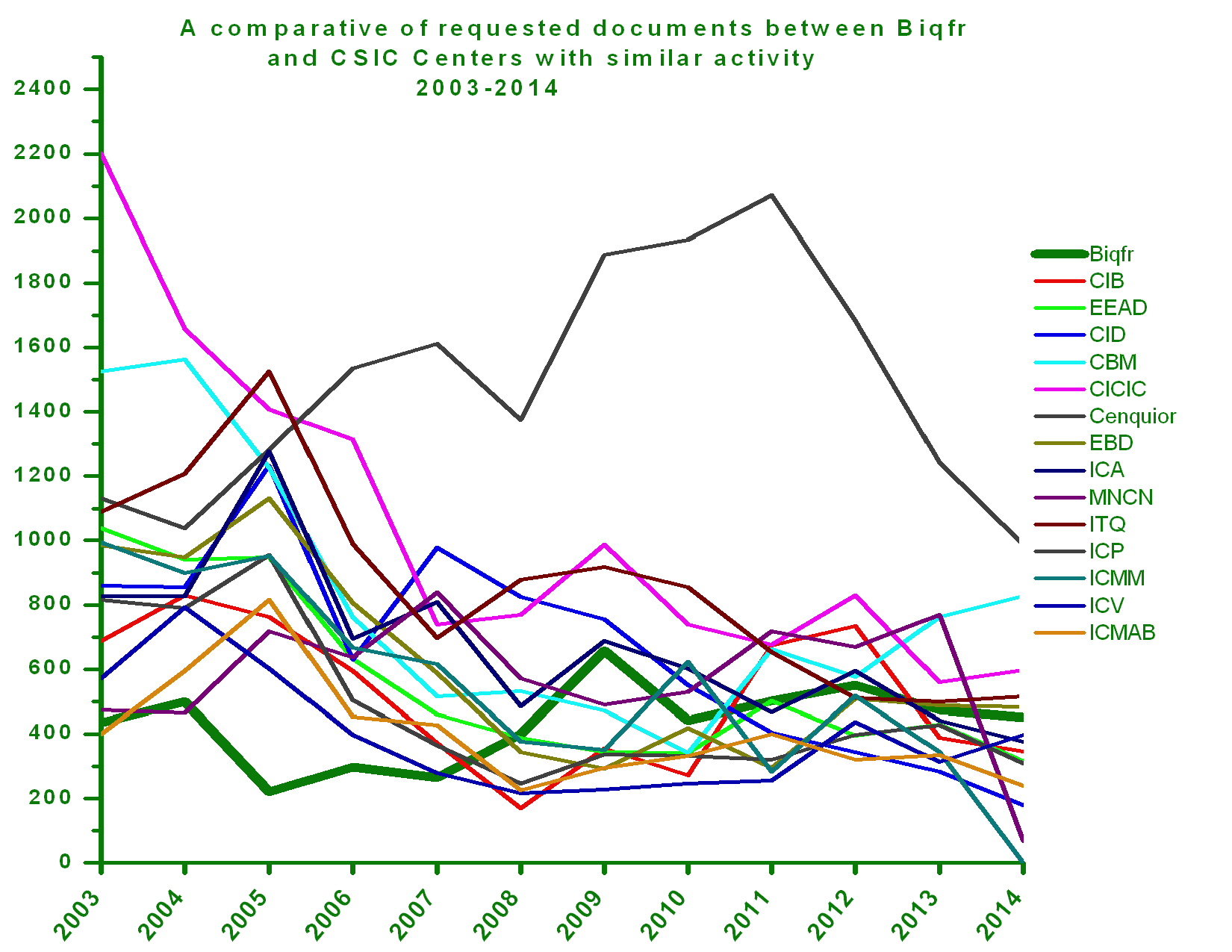| |
OUTLINE
The Rocasolano Institute of Physical Chemistry was set up in 1946 at same time as the  . Its holdings come from the "National Institute of Physics and Chemistry" created in 1932. Commonly known as the Rockefeller Institute, it was the cradle of all the research teams in the different disciplines of Chemistry, not only in Madrid, but throughout Spain. Three elements characterize the . Its holdings come from the "National Institute of Physics and Chemistry" created in 1932. Commonly known as the Rockefeller Institute, it was the cradle of all the research teams in the different disciplines of Chemistry, not only in Madrid, but throughout Spain. Three elements characterize the  : its Collection, Space and Management. : its Collection, Space and Management.
Among these old collections -unique in Spain- can be found famous titles such as: Annalen der Physik, Chemische Berichte, Annalen der Chemie. These are scientific journals in which the first advances in physics and chemistry are recorded. The  holds a valuable holding, mainly journals, of which 113 are complete starting from the first issue, 11 date from the 19th century to our days, and 16 start prior to 1920. holds a valuable holding, mainly journals, of which 113 are complete starting from the first issue, 11 date from the 19th century to our days, and 16 start prior to 1920.
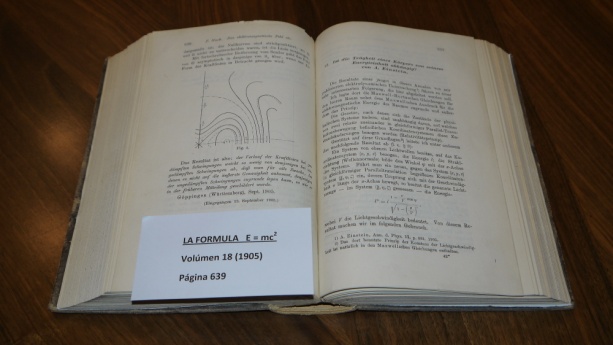 |
Einstein, A. (1905).
Ist die Trägheit eines Körpers von
Seinem Energieinhalt abhängig?
Ann. Phys. 18, 639-641.
The equation E=mc2
|
Designed by the architects M. Sánchez Arcas and L. Lacasa (1932), innovators at the time, the library is arranged longitudinally with the rest of the building. It has an easy access from the main entrance and faces South with three large windows illuminating the two floors containing the reading room. This provides a silent and conducive reading environment, according to the architect Antonio Bonet Correa. The floors were communicated inside with original spiral staircase of the "flown boat" style, which was recently replaced by another wooden one. Subsequently, a basement has been added and their rooms refurbished, while retaining the original style. Because of its singular interest the library is the subject of visits by architects from various universities.
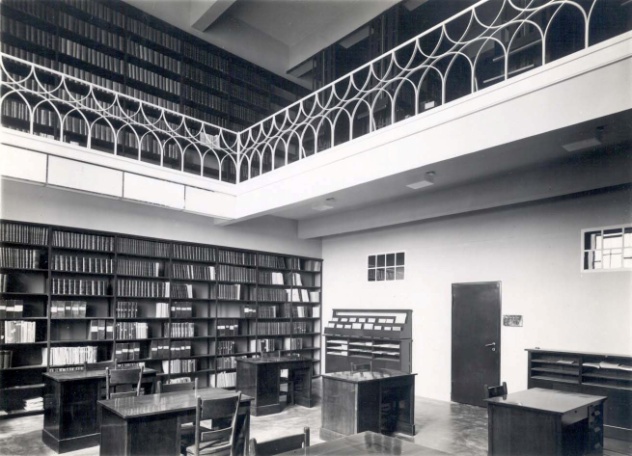 |
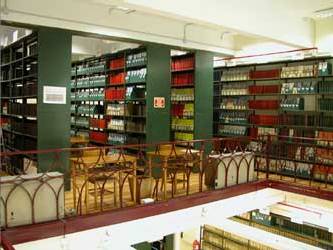 |
At its genesis, the  was organized in a way that was revolutionary for those days, free access was permitted, and display stands facilitated access to the latest and the previous year’s issues of the journals. The main goal has always been the satisfaction of its users. The was organized in a way that was revolutionary for those days, free access was permitted, and display stands facilitated access to the latest and the previous year’s issues of the journals. The main goal has always been the satisfaction of its users. The  is considered by the scientific community as the Reference Scientific Periodical Library, a historical landmark in the service of innovation, and is obviously one of the most outstanding scientific libraries in Europe. It is a rare example of 80 years of continuous service to Spanish researchers. is considered by the scientific community as the Reference Scientific Periodical Library, a historical landmark in the service of innovation, and is obviously one of the most outstanding scientific libraries in Europe. It is a rare example of 80 years of continuous service to Spanish researchers.
STRATEGIC GOALS
- New technologies.
- Access to knowledge.
- Document supply.
- Economic implication.
- Standard management.
- Special activity.
 New technologies: New technologies:
Since the beginning of technological age, in the 90s, the  has been aware that the technological changes, that were happening so quickly, provide an opportunity to the library to link it to the concept value. In recent years, this concept has been the mainstay of technical work to ensure that the library is competitive, proactive and even co-creative. By knowing the researchers' perception of the library in relation to the alternatives offered by its competitors (eg. Google), the has been aware that the technological changes, that were happening so quickly, provide an opportunity to the library to link it to the concept value. In recent years, this concept has been the mainstay of technical work to ensure that the library is competitive, proactive and even co-creative. By knowing the researchers' perception of the library in relation to the alternatives offered by its competitors (eg. Google), the  has developed links with scientists, to help researchers achieve their goals. Because of this, the has developed links with scientists, to help researchers achieve their goals. Because of this, the  has an edge on its competitors. has an edge on its competitors.
Let's put it on a timeline:
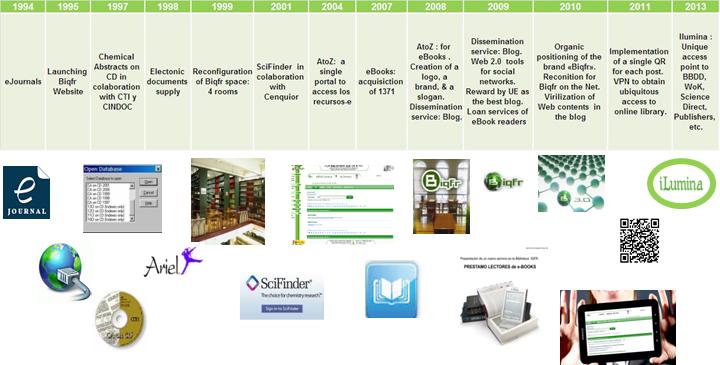 |
- The Blog & Social Networks: Out blog remains a key tool for dissemination and visibility. It posts news from all areas of science and innovation. In the period 2013-2014, there have been changes in the editorial line to promote and disseminate the activities developed in IQFR: Seminars series, conferences, activities of the Center and the
 . Always with the same purpose: trying to democratize "Science" and bring it to the public in a fun and an entertaining way. The interest of our blog's followers remains constant. During 2013-2014, 600 news items were published: an average of 2 per day! During this biennium, we achieved 257,369 visits to reach a total of 1,400,000 visits. The activity of our followers on the social networks Twitter and Facebook is constant and stable, as is the case with the Blog. The . Always with the same purpose: trying to democratize "Science" and bring it to the public in a fun and an entertaining way. The interest of our blog's followers remains constant. During 2013-2014, 600 news items were published: an average of 2 per day! During this biennium, we achieved 257,369 visits to reach a total of 1,400,000 visits. The activity of our followers on the social networks Twitter and Facebook is constant and stable, as is the case with the Blog. The  Blog is not only considered a scientific dissemination source in America (Mexico, Colombia, United States and Argentina) and Germany, but we have also detected that it begins to attract followers from other European countries (Russia, France, Switzerland & Ukraine) and even in Lebanon. Blog is not only considered a scientific dissemination source in America (Mexico, Colombia, United States and Argentina) and Germany, but we have also detected that it begins to attract followers from other European countries (Russia, France, Switzerland & Ukraine) and even in Lebanon.
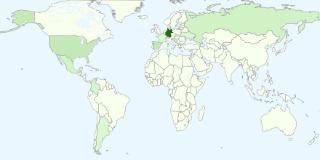 |
 Access to knowledge: Access to knowledge:
Over the last two years, a main goal has been the implementation of a smart tool to accelerate the search for scientific information, providing a competitive advantage to  over Google, while saving the user time and mouse clicks. Customization functionality has achieved a tool on demand: iLumina. over Google, while saving the user time and mouse clicks. Customization functionality has achieved a tool on demand: iLumina.
 |
All specialized databases in the fields of Chemistry, Physics and Biomedicine, to which users of the  have access, are brought together. Through a single search box, with one-click access to PDF or HTML, the user can access full-text content directly through the detailed record or from the result list preview pane. The AtoZ resource manager, can be utilized independently or through the iLumina system, where it is now incorporated. iLumina leverages with discovery technology (EBSCO Discovery EDS) employing a multi-faceted relevance ranking methodology, moreover setting up a unified index with all the have access, are brought together. Through a single search box, with one-click access to PDF or HTML, the user can access full-text content directly through the detailed record or from the result list preview pane. The AtoZ resource manager, can be utilized independently or through the iLumina system, where it is now incorporated. iLumina leverages with discovery technology (EBSCO Discovery EDS) employing a multi-faceted relevance ranking methodology, moreover setting up a unified index with all the  information resources to offer their users an easy and powerful access to the information resources to offer their users an easy and powerful access to the  holdings with a single search interface. Metadata from internal sources (A to Z) and external (supplier database) are managed, to create a large and high speed index. The resulting collection is vast in size and in scope, but local indexing allows exceptionally fast response times. holdings with a single search interface. Metadata from internal sources (A to Z) and external (supplier database) are managed, to create a large and high speed index. The resulting collection is vast in size and in scope, but local indexing allows exceptionally fast response times.
Main Features:
- Depth of indexing provides high-quality metadata for the most viewed
- Revelancy-ranked results speed users to the information.
- Rearchable full text available.
- Rich Metadata (Author Abstracts, Author Keywords, Subject Headings, Full Text of Articles, etc.)
- Customization of the specialized databases in activity area of
 to avoid noise. to avoid noise.
- Widgets for SciFinder, Reaxys, NIST, ICSD, Social Network, and more.
| Main Databases |
| arXiv |
Oxford |
| BioOne Online Journals |
Publisher Provided Full Text Searching File |
| Center for Research Libraries |
Research Starters |
| Directory of Open Access Journals |
SciELO |
| eArticle |
Science Citation Index |
| EDS Publication Finder |
ScienceDirect |
| J-STAGE |
Scopus |
| MEDLINE |
Supplemental Index |
At the end of 2013, the  project “iLumina” was launched as a single entry point to access to scientific information. Observing the results of the statistics, we find that many searches have been made with few queries, in addition, the returned results were analyzed carefully by consulting the abstracts, and then the most relevant and applicable search results were downloaded. project “iLumina” was launched as a single entry point to access to scientific information. Observing the results of the statistics, we find that many searches have been made with few queries, in addition, the returned results were analyzed carefully by consulting the abstracts, and then the most relevant and applicable search results were downloaded.
| Years |
Sessions |
Searches |
Abstracts |
Downloads |
| 2013 |
816 |
24.304 |
367 |
249 |
| 2014 |
2.570 |
42.951 |
2.035 |
820 |
- iLumina: Is available from the CSIC's site to the whole Institution, and ubiquitously through the VPN to
 users. Technology for mobile devices is offered. users. Technology for mobile devices is offered.
- AtoZ: The resources "A to Z" holds 30,654 journal & books. The
 current subscriptions are available on-line. current subscriptions are available on-line.
Simultaneously, this tool (A to Z) has been an access point to library’s electronic resources.
In 2013, the access for e_journals and for e-Books was brought together into a single interface, when the users were used to the application. 27,612 sessions were been made in 2013 and 15,812 in 2014. Whereas 15,747 researches have been achieved in 2013, with a decrease 10,798 in 2014
Upon launching iLumina, at the end of 2013, a decline is seen in activity, which strongly suggests that users prefer iLumina as a knowledge manager, while they still use "A to Z" for a particular citation.
 Supply Document: Inter librarian loan (ILL) Supply Document: Inter librarian loan (ILL)
The wealth of the  holdings satisfies the needs of its direct users, which is verified by the small number of documents requested to other centers and the significant number documents supplied to external centers such as universities, laboratories, and other CSIC centers. As expected from modern science, 98% of document transactions were journal articles and only 2% were book loans. Remarkably, the holdings satisfies the needs of its direct users, which is verified by the small number of documents requested to other centers and the significant number documents supplied to external centers such as universities, laboratories, and other CSIC centers. As expected from modern science, 98% of document transactions were journal articles and only 2% were book loans. Remarkably, the  supplied 17% of all the shared journal articles within the whole CSIC Library Network. supplied 17% of all the shared journal articles within the whole CSIC Library Network.
The ILL is the key indicator of a library's quality. The  has consolidated its position as the main supplier center at the CSIC. Over the last 14 years, the average has consolidated its position as the main supplier center at the CSIC. Over the last 14 years, the average ratio of the supplied documents to requested documents is ten. That is to say, the ratio of the supplied documents to requested documents is ten. That is to say, the  supplied 10 times more documents than we requested from other centers. In the last years, this value decreased to 7, due to the insertion at the Institute of research lines in the areas of "Life Sciences" whose resources are not directly available to our library. In contrast, on the whole, the CSIC Library Network is slightly deficitory as it requests 1.03 documents for every document that it shares. supplied 10 times more documents than we requested from other centers. In the last years, this value decreased to 7, due to the insertion at the Institute of research lines in the areas of "Life Sciences" whose resources are not directly available to our library. In contrast, on the whole, the CSIC Library Network is slightly deficitory as it requests 1.03 documents for every document that it shares.
Over the last years, the flow of internal transactions among CSIC libraries has dropped 35% compared to 2001-2003, due to the advance of new technologies and the collective contracting by CSIC of the large packages of electronic resources, provided by the main publishers and other Institutions.
Nevertheless the number of documents supplied to other institutions, has slowly decreased with sight fluctuations. The level of total transactions increased by 2.1 % between 2009 and 2010. On the other hand, it decreased in 2011 by 5.8%, to then experience an increase of 6.3% in 2012. This level is similar to that of 2007. However, in 2013 the number of documents loaned dropped by 6.3% and in 2014, it fell a further 12.8%. In 2014, we should remark that there was a 21% decline in the number of  supplied documents to the CSIC centers, which could be reasonably explained by a putative decrease of the CSIC's scientific activity and the closing of libraries at some CSIC centers. supplied documents to the CSIC centers, which could be reasonably explained by a putative decrease of the CSIC's scientific activity and the closing of libraries at some CSIC centers.
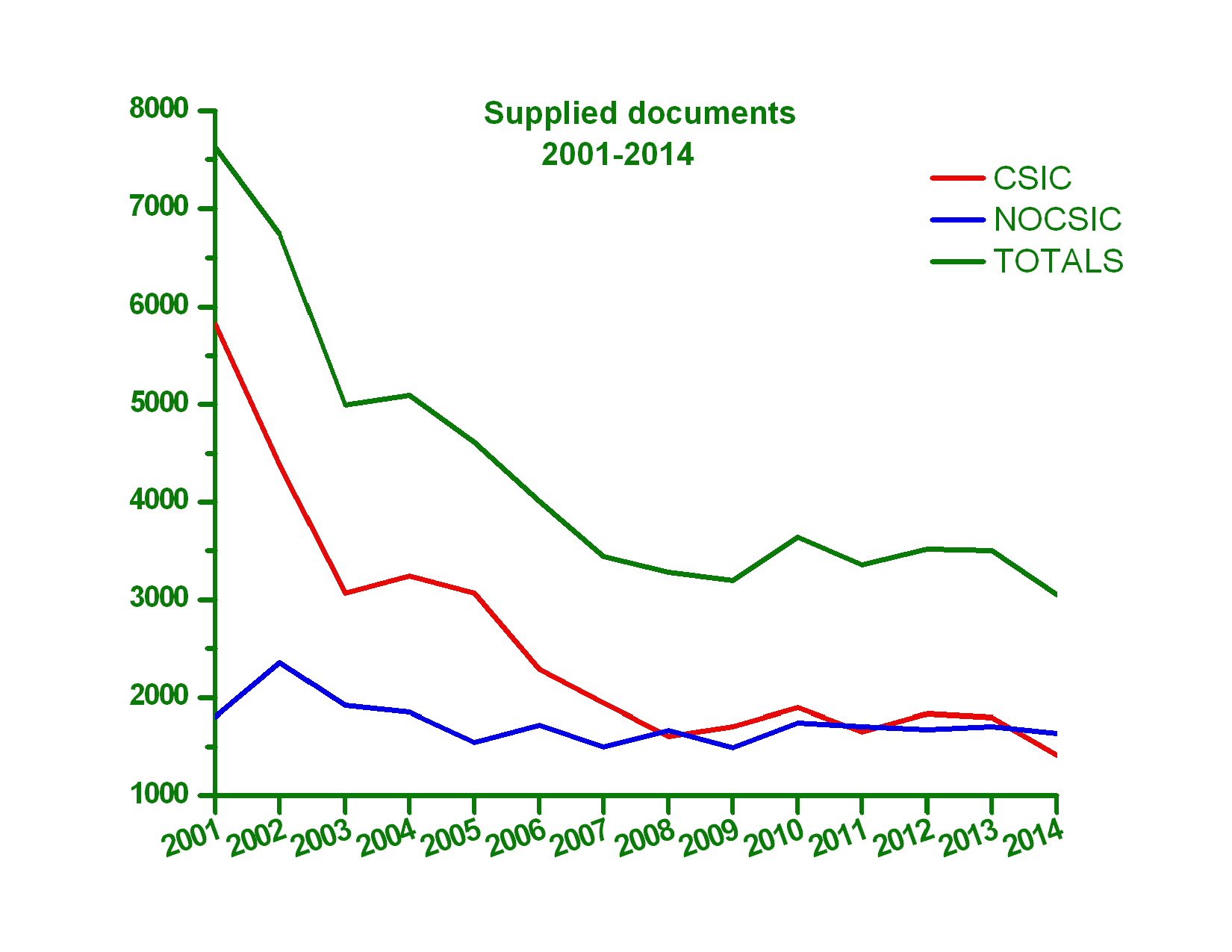 |
 |
During 2013: The total number of document transactions was 3,978 (both supplied and requested.) Of these, 3,505 documents were delivered (-0.3 % lower than 2012) with 1,800 being sent to the CSIC’s library Network (-2.1% lower than 2012) and 1,705 to other institutions (1.6% higher than 2012). Regarding our requests, 473 documents (14.1% lower than 2012); were obtained from other libraries, of which 219 (7.1% lower than 2012) came from CSIC's network and 254 documents (11.8 lower than 2012) were sent by other institutions. 19.7 % documents requested from other libraries were supplied by Subito. Of these 3,505 documents supplied, 3,366 came from journal articles and 31 were book loans.
During 2014: The total number of items loaned or borrowed was 3,505, of which 3,055 documents were delivered (12.8 % lower than 2013) with 1,420 being supplied to CSIC’s library Network (21.1% lower than 2013) and 1,635 to other institutions (4.1% lower than 2013). On the other hand, 450 documents (4.8% lower than 2013) were requested from other libraries, of which 251 (14.6% higher than 2013) came from CSIC's network and 199 (21.6 % higher than 2013) were sent by other institutions, with 25.6 % of these documents coming from Subito. Of these 3,055 documents supplied, 3,024 came from journal articles, while 31 were book loans.
The number of book loaned to users was 35 in 2013 and 38 in 2012. The number of book loaned showed a marked decrease of 53% compared with 2012.
 Economic implications Economic implications
During the last two years of economic crisis, the human and financial resources of the  , like the rest of the CSIC, have been severely damaged: , like the rest of the CSIC, have been severely damaged:
Our staff has been reduced by one third with one technician retiring and a second on extended leave. The remainder of the staff has been forced to fill gaps while maintaining its activity. In many cases this has been a difficult and arduous task, surpassed only by the goodwill and enthusiasm its members. The situation is further aggravated if you consider that staff is aging and further retirements are planned. This situation can not be extended for much more time without risking a possible closing of the library.
In 2010,  had a book acquisition budget of 46.430 €. Afterwards, a centralized office, the URICI (Unit of Information Resources for Research) was placed in charge of the acquisition of books for the libraries of the network, and had a book acquisition budget of 46.430 €. Afterwards, a centralized office, the URICI (Unit of Information Resources for Research) was placed in charge of the acquisition of books for the libraries of the network, and  has been uninvolved in the selection of books. Furthermore, since 2012 no funds have been allocated acquire new books or journal subscriptions. So, unfortunately, since 2013 no new books related to the IQFR's activity have been incorporated. has been uninvolved in the selection of books. Furthermore, since 2012 no funds have been allocated acquire new books or journal subscriptions. So, unfortunately, since 2013 no new books related to the IQFR's activity have been incorporated.
Furthermore, most journals are no longer subscribed to in paper, but only in the electronic format. Hence many are unavailable in the print edition, as is the case for the International Journal of Chemical Kinetics, Chemistry Letters, Russian Chemical Reviews (devoted to reviews, this is the English version of the legendary Uspekhi Khimii, the flagship of Russian Chemistry) etc. In 2013, due to economic cuts, many electronic resources were not subscribed to by the CSIC Library Network. In 2014 some subscriptions were renovated but all. This change represents an impoverishment of our cultural heritage, because some publishers (IOP, Wiley, Springer, etc.) cut electronic access when the subscription is dropped, even to the years that the journals were purchased in paper.
Currently only 44 journals are subscribed to in print, compared with 169 journals in 2012.
 Standard management: Standard management:
The  has continued the work of technical process, collections control, organization of the holding and signaling, maintaining the reading room service, etc. has continued the work of technical process, collections control, organization of the holding and signaling, maintaining the reading room service, etc.
In 2013, a project aimed to improve the collection by reviewing the holdings located in various IQFR offices or departments was executed. This required locating each of the 1193 items in different departments, checking to ensure that the location in the network collective catalog was correct, error correction if necessary, and finally, cataloging and classification of issues not included in the catalog.
 Special activities: Special activities:
In 2014, the  was entrusted with a special task by the President of the CSIC; namely, to support document management for the preparation of the book dedicated to the 75th anniversary of CSIC. was entrusted with a special task by the President of the CSIC; namely, to support document management for the preparation of the book dedicated to the 75th anniversary of CSIC.
We have also been involved with several holdings in exhibitions:
- Generación del 14. Ciencia y Modernidad (The Generation of 1914: Science and Modernity) organized by the National Library from March 14 to June 1, 2014.
- Marie Sklodowska Curie: una polaca en París (Marie Sklodowska Curie: a Polish Woman in Paris) organized by Museo de Ciencias Naturales (Natural Sciences Museum) from March 5th to Octubre 15th, 2014.
- La internacionalización de la cultura española (The Internationalization of Spanish Culture) organized by Residencia de Estudiantes (Students' Residence) from November 24th, 2014 to March 8th, 2015.
|
|

 was organized in a way that was revolutionary for those days, free access was permitted, and display stands facilitated access to the latest and the previous year’s issues of the journals. The main goal has always been the satisfaction of its users. The
was organized in a way that was revolutionary for those days, free access was permitted, and display stands facilitated access to the latest and the previous year’s issues of the journals. The main goal has always been the satisfaction of its users. The  is considered by the scientific community as the Reference Scientific Periodical Library, a historical landmark in the service of innovation, and is obviously one of the most outstanding scientific libraries in Europe. It is a rare example of 80 years of continuous service to Spanish researchers.
is considered by the scientific community as the Reference Scientific Periodical Library, a historical landmark in the service of innovation, and is obviously one of the most outstanding scientific libraries in Europe. It is a rare example of 80 years of continuous service to Spanish researchers.
 , like the rest of the CSIC, have been severely damaged:
, like the rest of the CSIC, have been severely damaged:


